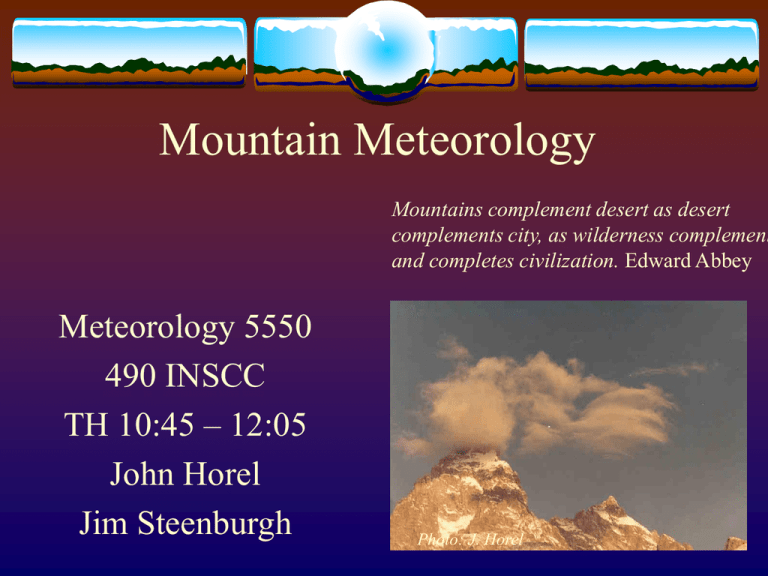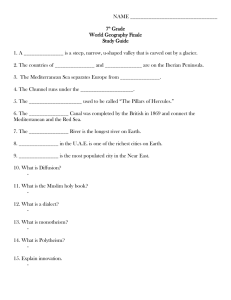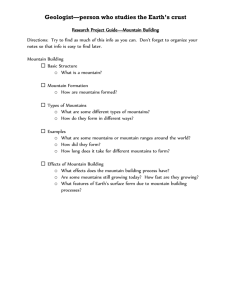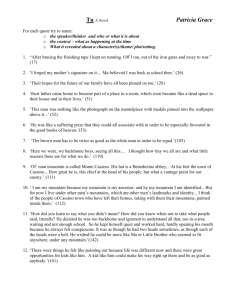lecture_1
advertisement

Mountain Meteorology Mountains complement desert as desert complements city, as wilderness complement and completes civilization. Edward Abbey Meteorology 5550 490 INSCC TH 10:45 – 12:05 John Horel Jim Steenburgh Photo: J. Horel Course Objectives and Content Understand the influence of the earth’s orography upon weather and climate First Half- John Horel Geographical controls of mountain weather and climate Terrain-forced flows Flow interaction with complex terrain Photo: J. Horel Course Content (cont.) Second half- Jim Steenburgh Orographically modified cyclones Orographically trapped disturbances Orographic precipitation Invited presentations Fire weather Air quality Avalanches Surface transportation Houze 1993 Grading 40%: Homework, class participation, literature reviews 20%: Participation and writeup of results from field experiment 20%: 1st half quiz 20% 2nd half quiz Source Material Mountain Meteorology. D. Whiteman. 2000. Mountain Weather and Climate. R Barry. 1992. Atmospheric Processes over Complex Terrain. W. Blumen 1990. Influence of Mountains on the Atmosphere. R. Smith. 1979. Advances in Geophysics. 21. Additional Reading Reading Assignments Many available on-line. To save trees, you are to access them on-line from campus and print them as needed http://ams.allenpress.com/amsonline/?request=inde x-html First Reading Assignment First reading assignment: Barry, R. G. (1978): H. B. de Saussure: the first mountain meteorologist. Bull. Amer. Meteor. Soc., 59, 702-5. Summarize in a few paragraphs: (1) who Saussure was; (2) how did he make the measurements and what were his results regarding the decrease of temperature with height; (3) what other contributions to mountain meteorology did he make? Due: via email at beginning of class on Aug. 30. Send to jhorel@met.utah.edu, Be prepared to discuss the reading during that class. Field Project Analysis of wind circulations on skijump slope Weather permitting Set up on Friday September 28 Observations Saturday morning September 29 Takedown in afternoon Requires planning in advance by class to design useful field project Requires analysis of data after data collection completed Photo: J. Horel VTMX Workshop September 10-12 Useful presentations on local wind circulations in Salt Lake Valley Plan on attending a few hours at some point instead of class on the 11th (and 13th?) What is a mountain? Common usage: 600 m or more of local relief defines a mountain Less than 600m is a hill High mountain/alpine areas (Troll 1973; Arct. Alp. Res., 5, 19-27): Relative to terrain features Upper timberline Snow line Himalayas: Photo credit: NASA/Science Photo Library What are the effects of mountains? Substantial modification of synoptic or meso scale weather systems by dynamical and thermodynamical processes through a considerable depth of the atmosphere Recurrent generation of distinctive wx conditions, involving dynamically and thermally induced wind systems, cloudiness, and precipitation regimes Slope and aspect variations on scales of 10-100 m form mosaic of local climates (Barry 1992) Effects of Mountains Carruthers and Hunt 1990 Whiteman (2000) http://infoplease.lycos.co m/ipa/A0001792.html Precipitation Barry (1992) Mountains % mountains as fraction of total land surface (land 30%) 0-1000 m 10% 1000-2000 m 3% 2000-3000 m 3% > 3000 m 4% Total 20% Barry 1992 %mountain as fraction of earth 6% Mt. Everest http://www.mteverest.com/ http://www.mnteverest.net/ http://www.m.chiba-u.ac.jp/class/respir/eve_e.htm http://www.newton.mec.edu/Angier/DimSum/Him. Range Pix.html Height of Mt. Everest: 8848m (http://www.m.chiba-u.ac.jp/class/respir/hyoko_e.htm) High Elevation Observatories Mt Washington http://www.mountwashington.org/ Storm Peak Laboratory http://www.dri.edu/Projects/SPL/ Geographical controls of mountain climate (Barry 1992) Latitude Continentality Altitude Topography Jeff Klein. SLC BLM) Jeff Klein. SLC BLM) Thermally forced terrain circulations Mountain-valley Slope winds flows Peter Sinks Experiment VTMX lake breeze Flow Interaction With Complex Terrain Buoyancy oscillations Flow over vs. around obstacles Kinetic and potential energy of flows Mountain waves Gravity wave drag Trapped lee waves Photo: J. Horel Downslope Windstorms Conceptual models Observations Numerical studies Gap winds L. Darby & R. Banta, ATDD/ETL Other subjects Orography Mountain Physiology and the General Circulation torque of high altitude Climate change at high altitude 1st Homework Assignment Bring in a couple (to as many as you want) of mountain and mountain weather related photos Be prepared to say a few words about 1-2 photos If you’re willing to allow use of the photos for this class and future classes, scan the images on the PC in Rm 480 (details to be provided, but don’t leave them with me) Due: whenever Homework Assignment #2 (1) Find 5 interesting and useful internet web pages related to mountain weather, mountain climates, or alpine environments (2) Send me in 1 email the web addresses with a 1-2 sentence description of the content of each page (3) Provide at least 2 scientific, literary, or artistic (music/art) definitions or descriptions of mountains. Not from dictionaries (4) Provide a reference/source for that definition and send it in the same email as that used above Due August 30 Parameters used to define flow (Smith 1979) Parameter Symbol Units Typical Value Mountain height h km 1 Width downstream Lx km 10 Width crossstream Ly km 100 Flow layer depth H km 1 PBL; 10 troposphere Incoming windspeed u m/s 10 Incoming wind shear uz s-1 10-3 Stability frequency N s-1 10-2 Coriolis parameter f s-1 10-4 Buoyancy/reduced gravity b = d qg/q m/s2 10-1





